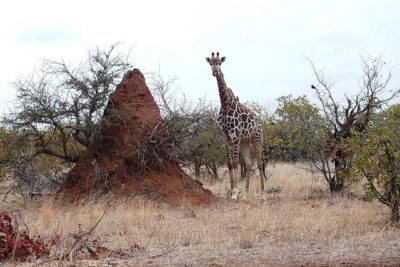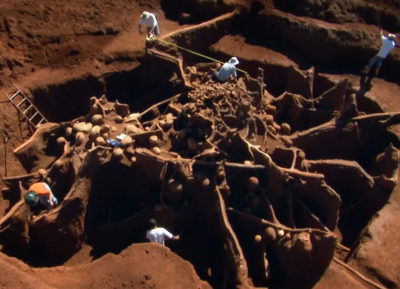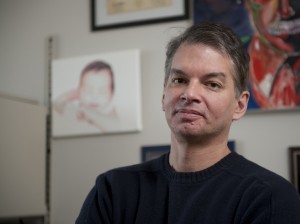 Charles Darwin wrestled to understand the interplay between instincts and natural selection. By observing ants, he hoped to connect the two. In The Origin of Species, Darwin argued –
Charles Darwin wrestled to understand the interplay between instincts and natural selection. By observing ants, he hoped to connect the two. In The Origin of Species, Darwin argued –
“We shall, perhaps, best understand how instincts in a state of nature have become modified by selection, by considering… the slave-making instinct of certain ants.”
Ant instincts have emerged as a problem for Darwin, however, along with his other major issue, transitional links. As Darwin explains in his introduction to the Origin of Species –
“The most apparent and gravest difficulties on the theory… namely, first, the difficulties of transitions… [and], secondly, the subject of Instinct.”
Self-Organize
Without a blueprint or a leader, ants self-organize to cooperatively move dirt and sand to create large structures, apparently instinctively. These often include an integrated network of elaborate tunnels, complete with circulating ventilation.
Ants can overcome obstacles to complete a task. As they work, ants can run at a human equivalent of sixty miles per hour, spontaneously forming three lanes of traffic. To avoid traffic jams, they open a center lane for homeward bound ants with two outward bound lanes flanking the center lane.
Scientists, attempting to understand the origin of these self-organization behaviors, often look to the ant, as Darwin did. In the article “The Remarkable Self-Organization of Ants,” Simon Foundation senior science writer for Quanta Magazine, Emily Singer (pictured right), explains –
“Scientists have been studying the social behavior of ants and other insects for decades, searching for chemical cues and other signals that the insects use to coordinate behavior.”
Colony Design
 Fortunately, the beauty of an ant colony is hidden. A video of an African ant colony structure (pictured left), entitled the “Giant Ant Colony,” produced by the Science Channel, demonstrates the enormous size of one of these underground structures. As the narrator explains, it “looks like it [the ant colony] was designed by an architect – a single mind,” yet –
Fortunately, the beauty of an ant colony is hidden. A video of an African ant colony structure (pictured left), entitled the “Giant Ant Colony,” produced by the Science Channel, demonstrates the enormous size of one of these underground structures. As the narrator explains, it “looks like it [the ant colony] was designed by an architect – a single mind,” yet –
“This colossal and complex city was created by the collective will of the ant colony–the superorganism.”
For good reasons, instinct was one of Darwin’s “gravest difficulties,” then. Now, not surprisingly, despite more than 150 years of technological and scientific advances, a natural explanation for the evolution of ant instinct remains to be discovered.
Colony Size
To build the more than 500 square feet structure that dives more than 25 feet underground, as seen in the video, “the colony moved 40 tons of soil… with millions of ant loads of soil brought to the surface.” For size comparison, the narrator continues –
“Each load weighed four times as much as the worker ant and in human terms, was carried over a half-mile to the surface. It is equivalent to building the Great Wall of China… it is truly a wonder of the world.”
More Questions
Rather than providing a natural explanation, these astonishing behaviors observed in the ant have only generated more questions than answers. As Singer explains,
“More broadly, identifying the rules that ants obey could help scientists understand how biologically complex systems emerge — for example, how groups of cells give rise to organs.”
While the evidence “could help,” it hasn’t. Scientists are still without a mechanism to explain how “groups of cells give rise to organs,” no less, ant instincts.
Instincts are an evolutionary enigma. In an interview with Singer, Simon Garnier (pictured right), a biologist at the New Jersey Institute of Technology, discusses the issue –
“It’s a fascinating question to understand how individuals that are less cognitively able than we are can collectively achieve results that are sometimes better than what we can do with our big brains.”
Guy Theraulaz, a French behavioral biologist at the French Research Center on Animal Cognition, has been studying animal instincts for more than 20 years. “Collective intelligence” is his term for colony instincts.
By carefully observing and categorizing ant’s instinctive behaviors, Theraulaz developed an AI computer model. According to Singer –
“[The computer] created pillars that looked just like those made by their biological counterparts [ants].”
Ant instincts, like designed AI programs, cannot be produced by random chance events, as advanced by the evolution industry. Darwin’s dilemma intensifies.
Ant Transitional Links
More than 20,000 species of ants are known. While some form small colonies, other species form highly organized colonies with a population in the millions, a virtual megalopolis.
Darwin predicted the discovery of “innumerable” transitional links, which would resolve his “difficulties.” However, even among these widely varying ant species, today, not one ant species is scientifically validated as a transitional link.
Discovering a natural mechanism for the origin of ant instincts has long evaded evolutionary scientists, dating back as far as Darwin. As Chris Adami (pictured left), a physicist and computational biologist at Michigan State  University, explained to Singer,
University, explained to Singer,
“If we can understand how rules emerge from other rules and how they change with the environment, that would be extraordinarily fruitful.”
Without quantum advances in technology, however, Adami’s pursuit will undoubtedly remain beyond the reach of science. Singer’s conclusion is consistent with Darwin’s –
“[What is] currently missing is an evolutionary approach.”
Genesis
While the origin of ant instincts, like that of the atom, continues without a known natural explanation, they are consistent with the Genesis account. As Louis Pasteur, a French chemist and microbiologist, concluded during the Scientific Revolution –
“Everything grows clear in the reflections from the Infinite.”
Refer to the Glossary for the definition of terms and to Understanding Evolution to gain insights into understanding evolution.

